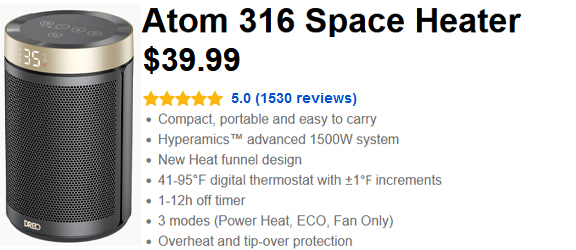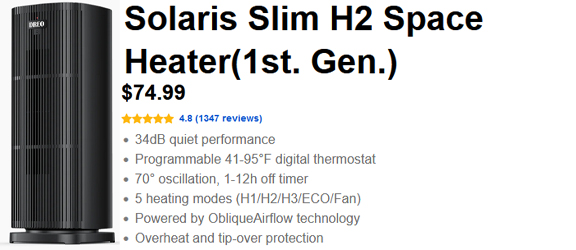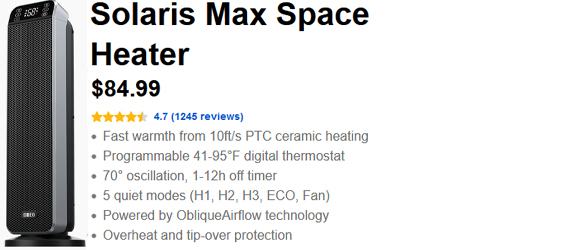
Space heaters are devices that can provide supplemental or primary heating for a specific area or room. They are especially useful for people who live in cold climates or have inadequate or expensive central heating systems. However, not all space heaters are created equal. Some space heaters consume more energy and cost more money than others, while some space heaters are more efficient and eco-friendly than others. In this blog post, we will explore the different types of space heaters and how to choose the most economical ones for your needs.
Factors to consider when choosing a space heater
Before buying a space heater, you should consider the following factors:
- Size and capacity: The size and capacity of a space heater determine how much space it can heat up and how fast it can do so. You should choose a space heater that matches the size of your room and your heating needs. A general rule of thumb is to multiply the square footage of your room by 10 to get the wattage of the space heater you need. For example, if your room is 150 square feet, you need a space heater that can produce 1500 watts of heat.
- Energy efficiency: The energy efficiency of a space heater indicates how much of the electricity it consumes is converted into heat. The higher the energy efficiency, the lower the operating cost and the environmental impact. You should look for space heaters that have energy-saving features, such as thermostats, timers, auto-shutoff, and eco-modes. You can also check the energy star rating or the annual fuel utilization efficiency (AFUE) rating of the space heater to compare its energy performance with other models.
- Safety: The safety of a space heater is another important factor to consider, as space heaters can pose fire and burn hazards if not used properly. You should look for space heaters that have safety features, such as tip-over protection, overheat protection, cool-to-touch surfaces, and certification from reputable organizations, such as UL, ETL, or CSA. You should also follow the safety instructions and precautions provided by the manufacturer and avoid placing the space heater near flammable materials, children, or pets.
Types of space heaters and their pros and cons
There are three main types of space heaters: electric, gas, and wood. Each of them has its own advantages and disadvantages in terms of efficiency, cost, and environmental impact.
Electric space heaters
Electric space heaters are powered by electricity and use various heating elements, such as ceramic, metal, or infrared, to produce heat. They are the most common and convenient type of space heaters, as they are easy to use, portable, and versatile. However, they are also the most expensive and energy-intensive type of space heaters, as they consume a lot of electricity and can increase your utility bills. Moreover, depending on the source of electricity, electric space heaters can also contribute to greenhouse gas emissions and air pollution.
Some of the most economical electric space heaters are:
- Ceramic space heaters: These space heaters use ceramic plates that are attached to metal coils. As electricity passes through the coils, the ceramic plates heat up and release heat into the air. Ceramic space heaters are compact, lightweight, and instant. They can also oscillate and have cool-to-touch surfaces. However, they are not very effective for heating large spaces and can be blocked by physical objects. An example of a ceramic space heater is the Lasko CD09250 Ceramic Space Heater.
- Infrared space heaters: These space heaters use infrared rays that are invisible to the human eye. As electricity passes through a quartz tube or a metal filament, it emits infrared rays that heat up the objects and people in their path. Infrared space heaters are efficient, silent, and safe. They can also provide a natural and cozy warmth. However, they are not very good for heating the air and can be affected by drafts and humidity. An example of an infrared space heater is the LifeSmart Infrared Quartz Fireplace.
- Convection space heaters: These space heaters use a fan or a natural airflow to circulate the heated air throughout the room. They can be either fan-forced or oil-filled. Fan-forced space heaters use a metal coil or a ceramic plate that heats up the air and a fan that blows it out. Oil-filled space heaters use a sealed reservoir of oil that heats up and radiates heat through metal fins. Convection space heaters are effective, consistent, and long-lasting. They can also heat up large spaces and maintain a comfortable temperature. However, they are slow, noisy, and hot to the touch. An example of a convection space heater is the Klarstein Bornholm Convection Panel.
Gas space heaters
Gas space heaters are fueled by natural gas or propane and use a burner or a catalytic converter to produce heat. They are more efficient and cost-effective than electric space heaters, as they can heat up a larger area with less energy. They are also independent of the power grid and can be used in case of a power outage. However, gas space heaters also have some drawbacks. They require proper ventilation and installation to prevent gas leaks, carbon monoxide poisoning, and fire hazards. They also emit nitrogen oxides, carbon monoxide, and other air pollutants that can worsen indoor and outdoor air quality and cause respiratory problems.
Some of the most economical gas space heaters are:
- Ventless gas space heaters: These space heaters do not have a vent or a chimney to expel the combustion gases. Instead, they use a sensor and a regulator to control the oxygen and gas levels and shut off the heater if they detect a problem. Ventless gas space heaters are efficient, compact, and easy to install. They can also provide a lot of heat and save on heating costs. However, they are not very safe, as they can release harmful gases and moisture into the room. They are also banned or restricted in some states and regions. An example of a ventless gas space heater is the Mr. Heater F299730 Vent-Free Blue Flame Gas Heater.
- Vented gas space heaters: These space heaters have a vent or a chimney to expel the combustion gases outside. They are safer and cleaner than ventless gas space heaters, as they reduce the risk of gas leaks, carbon monoxide poisoning, and air pollution. They are also more reliable and durable, as they can operate in any weather condition and last longer. However, they are less efficient and more expensive than ventless gas space heaters, as they lose some heat through the vent and require more installation and maintenance. An example of a vented gas space heater is the Rinnai FC824P Vent-Free Propane Gas Heater.
Wood space heaters
Wood space heaters are fueled by wood logs, pellets, or chips and use a combustion chamber or a stove to generate heat. They are the most traditional and natural type of space heaters, as they can create a cozy and rustic atmosphere. They are also renewable and carbon-neutral, as they use biomass that can be replenished and offset the carbon dioxide emissions. However, wood space heaters are also the most polluting and hazardous type of space heaters. They produce large amounts of particulate matter, carbon monoxide, volatile organic compounds, and other toxic substances that can impair lung function and increase the risk of cancer. They also pose fire and burn risks if not handled properly and require a lot of storage and cleaning.
Some of the most economical wood space heaters are:
- Wood stoves: These space heaters use wood logs that are burned in a metal or cast iron box. They are simple, sturdy, and efficient. They can also provide a lot of heat and a pleasant ambiance. However, they are not very clean, as they emit a lot of smoke and ash. They also need a chimney or a flue to vent the gases and a fireproof surface to place the stove. An example of a wood stove is the [Drolet HT3000 Wood Stove].
- Pellet stoves: These space heaters use wood pellets that are compressed from sawdust and other waste materials. They are more advanced, sophisticated, and eco-friendly than wood stoves. They can also provide a consistent and controlled heat and a low level of emissions. However, they are not very cheap, as they require electricity to operate and wood pellets to fuel. They also need a vent or a chimney to expel the gases and a hopper to store the pellets. An example of a pellet stove is the [Castle Serenity Wood Pellet Stove].
Conclusion
Space heaters are devices that can provide supplemental or primary heating for a specific area or room. They are especially useful for people who live in cold climates or have inadequate or expensive central heating systems. However, not all space heaters are created equal. Some space heaters consume more energy and cost more money than others, while some space heaters are more efficient and eco-friendly than others. In this blog post, we have explored the different types of space heaters and how to choose the most economical ones for your needs. We have also provided some examples of the most economical space heaters in each category. We hope this blog post has helped you find the best space heater for your home and budget. Stay warm and save money!





